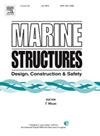Ship collision model tests in a water tank
IF 4
2区 工程技术
Q1 ENGINEERING, CIVIL
引用次数: 0
Abstract
This paper investigates the dynamic responses and energy distribution in perpendicular collisions using model tests, in which the three primary elements are involved simultaneously: fluid effects, global ship motions, and local elastoplastic responses. A novel in-tank ship collision testing system has been developed to simulate perpendicular ship collisions, where the struck ship is impacted at its central section. The dynamic process of ship motions, structural deformation, energy dissipation, and added mass during collision are analyzed. Three collision scenarios are examined: Perpendicular Collision (PC), Planar Perpendicular Collision (PPC), and Central Perpendicular Collision (CPC). The calculation of energy loss during collision based on PC gives a good fit to the experimental results. It is found that the energy dissipation in the collision test is approximately linearly correlated with the initial energy input to the system. On average, about 51% of the initial kinetic energy is dissipated in the collision, mainly absorbed by the side structure through plastic deformation. These experimental data can be used for benchmarking the theoretical and numerical methods, and useful insight is provided for assessing collision scenarios.
在水箱中进行船舶碰撞模型试验
本文采用模型试验的方法研究了垂直碰撞中的动力响应和能量分布,同时考虑了流体效应、船舶整体运动和局部弹塑性响应三个主要因素。本文研制了一种新型的油罐内船舶碰撞试验系统,用于模拟船舶垂直碰撞,即被撞船舶在其中部受到撞击。分析了碰撞过程中船舶运动、结构变形、能量耗散和附加质量的动力过程。研究了三种碰撞场景:垂直碰撞(PC)、平面垂直碰撞(PPC)和中央垂直碰撞(CPC)。基于PC的碰撞能量损失计算与实验结果吻合较好。研究发现,碰撞试验中的能量耗散与系统初始能量输入近似线性相关。平均约51%的初始动能在碰撞中耗散,主要通过塑性变形被侧面结构吸收。这些实验数据可用于对理论和数值方法进行基准测试,并为评估碰撞场景提供有用的见解。
本文章由计算机程序翻译,如有差异,请以英文原文为准。
求助全文
约1分钟内获得全文
求助全文
来源期刊

Marine Structures
工程技术-工程:海洋
CiteScore
8.70
自引率
7.70%
发文量
157
审稿时长
6.4 months
期刊介绍:
This journal aims to provide a medium for presentation and discussion of the latest developments in research, design, fabrication and in-service experience relating to marine structures, i.e., all structures of steel, concrete, light alloy or composite construction having an interface with the sea, including ships, fixed and mobile offshore platforms, submarine and submersibles, pipelines, subsea systems for shallow and deep ocean operations and coastal structures such as piers.
 求助内容:
求助内容: 应助结果提醒方式:
应助结果提醒方式:


